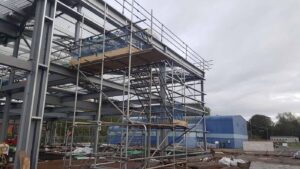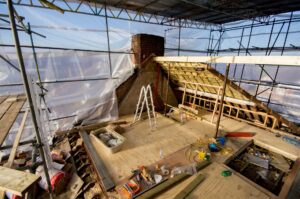
How Long Does It Take to Erect Scaffolding?
The purpose of scaffolding (whether domestic or commercial) is to provide a safe working platform for people engaged in a variety of activities on the upper floors of a building’s exterior.
Burntwood - 01543 399690
Cannock - 01543 221448
Dudley - 01384 437134
Lichfield - 01543 221448
Rugeley - 01889 227335
Stafford - 01785 904500
Walsall - 01922 927027
Wolverhampton - 01902 921819
Whether you’re repainting your window frames or making repairs to your roof, sometimes it’s difficult to tell whether you actually need scaffolding. Is it too high for a ladder? Can I reach everything I need to from the window, and is it safe to do so? Perhaps these are questions you’ve asked yourself before. But you don’t have to leave it to chance: there exist several criteria, based on both safety and practicalities, that determine whether scaffolding will be more suitable for the job at hand.
In this article we give four key factors that will help you tell if you need scaffolding.
Working at height refers to any project that involves working more than 4.5m (15’) off the ground. Generally, this means anything above the ground floor. There are three common ways to access projects at this height – ladders, extendable cherry pickers, or scaffolding. While all three have their advantages, only scaffolding guarantees a safe, secure platform from which to work at height. Ladders are too restrictive, while cherry pickers are expensive and require at least one trained and experienced operator to get them into place.
Any project that involves working at height for more than a day or two would benefit from a scaffolding solution. Traipsing up and down ladders for an extended period of time can be very tiring, especially if you’re carrying tools, materials, or paints. If your workers become exhausted, they run the risk of slipping on their ladder.
Some jobs simply cannot be accomplished effectively from a ladder. If you’re painting the outside of a building, re-shingling an entire roof, or building a second storey extension, working from a ladder restricts how effective you can be. You have an area of movement only a few feet either side or directly in front of you. Reaching out further to extend that area is a major health and safety risk and you should seriously consider a scaffolding solution to remedy that.
While British weather can be erratic at the best of times, at certain points in the year they can be predictably awful. Building during the autumn and winter months involves working in strong winds, freezing cold, and driving rain. These are awkward conditions even at ground level. When working at height they can be downright dangerous. With scaffolding in place you have some measure of shelter, as well as safety rails and wide platforms to work from, making for a much safer working environment.

A professionally built scaffold offers several advantages to any construction, repair, or renovation project. These are some the most popular benefits:
Any job that requires working at height for extended periods of time should involve a scaffold for the safety of its workers. These are some of the more common tasks, where you might expect to see scaffolding as an integral part of the job site:
If you have a project in Cannock, Stafford, or anywhere else across the Staffordshire region that needs a quality domestic scaffolding or commercial scaffolding service, contact Cannock Wood Scaffolding today. We provide end-to-end scaffolding solutions from an initial consultation and site analysis, through the scaffolding build, all the way to dismantling and removing it once the job is done. Contact us on 01543 379 112 or 07866 672 460 or send an email to cwscaff@gmail.com to receive a free, no-obligation quote.

The purpose of scaffolding (whether domestic or commercial) is to provide a safe working platform for people engaged in a variety of activities on the upper floors of a building’s exterior.

The purpose of scaffolding (whether domestic or commercial) is to provide a safe working platform for people engaged in a variety of activities on the upper floors of a building’s exterior.

Any kind of outdoor construction project in the UK runs the risk of being affected by inclement weather conditions, be it rain, wind, or snow,

When working from height, many people prefer to hire a scaffolding company to make the project safer for all involved…

While infinitely safer than relying on ladders and luck, working on a scaffold remains a dangerous project if you don’t take the proper precautions.
| Cookie | Duration | Description |
|---|---|---|
| cookielawinfo-checkbox-analytics | 11 months | This cookie is set by GDPR Cookie Consent plugin. The cookie is used to store the user consent for the cookies in the category "Analytics". |
| cookielawinfo-checkbox-functional | 11 months | The cookie is set by GDPR cookie consent to record the user consent for the cookies in the category "Functional". |
| cookielawinfo-checkbox-necessary | 11 months | This cookie is set by GDPR Cookie Consent plugin. The cookies is used to store the user consent for the cookies in the category "Necessary". |
| cookielawinfo-checkbox-others | 11 months | This cookie is set by GDPR Cookie Consent plugin. The cookie is used to store the user consent for the cookies in the category "Other. |
| cookielawinfo-checkbox-performance | 11 months | This cookie is set by GDPR Cookie Consent plugin. The cookie is used to store the user consent for the cookies in the category "Performance". |
| viewed_cookie_policy | 11 months | The cookie is set by the GDPR Cookie Consent plugin and is used to store whether or not user has consented to the use of cookies. It does not store any personal data. |